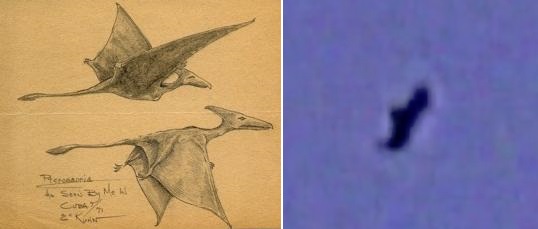By modern-pterosaur investigative journalist Jonathan Whitcomb
Modern pterosaurs come in two flavors, apparently similar to what scientists have found in fossils of those featherless flying creatures from the past:
- Long-tailed Rhamphorhynchoid-like
- Short-tailed Pterodactyloid-like
Contrary to the surface appearance from looking at a statistic in my compilation of data early in the year 2013, extant pterosaurs in modern times do not likely actually involve a 20-to-1 ratio of long-tails to short-tails. The long tails catch the attention of the eyewitness, riveting that feature in the memory of the person who sees it. It could be a ratio of 5-to-1 or even 3-to-1, but long tails unquestionably dominate sightings, compared with short tails.
With 41% of the 128 sightings including descriptions of a long tail, the Rhamphorhynchoid-like ones surely outnumber the Pterodactyloid-like ones. Shocking as the existence of a species of modern pterosaur may be to peoples of Western cultures, this statistical fact gives a whole new level of shock, for it strongly suggests that evolution has not taken place in these featherless flying creatures in anything remotely like what’s been portrayed.
In the image shown below, the left side is the sketch drawn by the eyewitness Eskin Kuhn in 1971 at Guantanamo Bay, Cuba; the right side is a still image from a video recorded by the biologist Peter Beach, during an expedition on New Britain Island, Papua New Guinea, in 2015. Both sightings appeared to have been of modern pterosaurs.
The left side shows an obvious similarity to end-of-tail flanges of Rhamphorhynchoids; the right side shows the absence of any long tail on the huge featherless flying creature that was seen clearly in daylight by two American explorers.
.

Rhamphorhynchoid-like in 1971 (left) and Pterodactyloid-like in 2015
We need to keep an open mind to the possibility that we should set aside old ideas about the origins of pterosaurs known from fossils, including popular concepts from previous centuries. This field of cryptozoology needs to graduate into a new field of investigation in biology.
About Jonathan Whitcomb
I’m an independent investigative journalist, having spent more hours in this narrow field of cryptozoology, during the past fifteen years, than any other person in the world, to the best of my knowledge: well over 10,000 hours.
Some of my work has been interviewing eyewitnesses of apparent living pterosaurs, sometimes by phone but usually by emails. On occasion I visit the location of a sighting, and I sometimes travel to interview eyewitnesses face-to-face. Most of my time, however, has been with analyzing, comparing, and writing about the sightings. I’ve had direct contact with eyewitnesses from five continents (not counting second-hand and third-hand accounts).
###
.
Those interviews in Papua New Guinea in 2004 do not scientifically prove the ropen is very closely related to the Sordes pilosus, but it gives strong cryptozoological evidence that it may be related to that pterosaur known from fossils.
.
About twelve cryptozoologists who have played a major role in this field of cryptozoology: modern non-extinct pterosaurs
.
Unicornorism and Living Pterosaurs
Protecting old ideas by appealing to how long they have been popular or to how popular they are. This is the main enemy to objective living-pterosaur investigations, this dogmatic position of many Westerners.
.
Late in 2006, Garth Guessman, a living-pterosaur investigator, interviewed three Americans who had worked in or visited a medical mission in Central New Britain Island, Papua New Guinea. The three had separate sightings, in daylight, of what may be extant (non-extinct) Pterodactyloids. (short-tailed pterosaurs, a.k.a. “pterodactyls”)
.
No tail on flying creature – expedition in 2015
. . . two Americans, Milt Marcy and Peter Beach, were searching for a living pterosaur. They spent quite a few weeks on that remote tropical island [New Britain, Papua New Guinea] in 2015, but they were rewarded with a sighting of a flying creature that others had previously seen in that area: a non-extinct pterosaur.
.
How common is a long tail on a modern pterosaur! Of the 128 more-credible sighting reports compiled at the end of 2012, 41% reported a long tail.
.
Many years ago, I tried (without success) to get in touch with Allison Jornlin, the writer of an article on a pterosaur sighting in Wisconsin: “PTERODACTYLS OVER WISCONSIN — STRANGE THINGS ARE HAPPENING IN THE SKY!”


